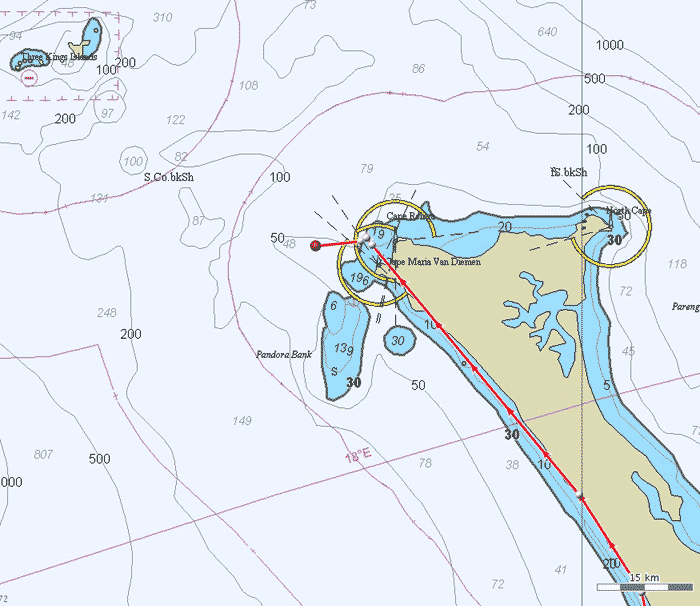 |
| View from the "Duke's Nose" hike in Whangaroa Harbour |
Back in NZ in January and the goal was to sail south: after almost 18
months spent in New Zealand, we still hadn’t seen anything of the South Island,
so this summer was our chance. We planned to heed the local's mantra when it comes to getting from Northland to South Island: “West is best, East is a beast.” We’d been poring over MetVuw’s online weather while in
Tassie and it seemed that a great weather window was on it’s way, so as soon as
we were fueled, watered and provisioned we were out of Opua like a shot and
soon heading toward Cape Reinga.
Our first attempt round the top was a no-go, at the last minute we decided that forecast headwinds would make life too miserable a few days out, so back we bashed toward Mangonui; disappointing,
but sometimes things work out for the best; as we malingered around in NZ’s Far
North, we were far from any crowds and were lucky to bump into a few friends!
 |
| Anchorage at the Cavalli Islands |
We anchored for a couple of nights at the Cavalli Islands,
which seemed nearly tropical in high summer. There we
met up with our friends on Sam, who’d just returned from a Christmas vacation
sailing trip to Tasman Bay and back. They gave us a great fish dinner and a Tasman Sea weather pep talk, And the next day who should anchor next to
us but the Lady Crossley, the WWII era launch that Mike had helped refurbish
while working in Opua. Jamie and Margot are very gracious folks and treated us to dinner a couple of times.
 |
| Picara and the Lady in the Cavallis |
Margot is a history buff and gave us a fascinating book on the history of Whangaroa and the northern coast. It is one of the first areas where Maori people had contact with Europeans and some of the stories are pretty amazing. One that sticks in my mind involved two high-ranking Maori young men who were kidnapped from the Cavalli Islands by a British trading vessel, which was following orders to bring Maoris who were knowlegeable about producing fabric from the native flax plants to the prison colony on Norfolk Island. The Brits were hoping that their convict workforce would be able to turn out sails and cordage from their island prison. Unfortunately, it turned out that flax processing was women's work and the two men knew nothing about it! Oops. The Maoris were eventually returned to their home.
 |
| Ruins of the once-productive shipyard in Totara North. |
Another interesting thing about Whangaroa is that, like quite a few spots in NZ during the 19th century, it's supply of timber made it a centre for shipbuilding. Schooners up to 150 feet in length were built in the community of Totara North, in sheds that are now quietly slumping back into the mangroves.
 |
| Uncrowded anchorage in Whangaroa - Duke's Nose is the knobby one on the left. |
|
|
|
 |
| What a great idea! No need to go to the marina: filling up at the water bouy in one of the northern arms of Whangaroa Harbour. |
 |
| Looking into the harbour from the top of the Rangikapiti Pa at Mangonui |
Even with a huge headstart, we lost a slow-motion race to the lovely SY Alegresse as we coasted slowly west from Whangaroa to Doubtless Bay (Capt Cook couldn't be bothered to go in and explore it, apparently, just said "doubtless, a bay") and the well-protected Mangonui Harbour. (Mango=shark, nui=big). It's a cute little holiday town with a fair bit of small coastal fishing boat traffic and a famous fish and chips shop. This was at one time a major whaling port, and many of the old buildings are still standing. Maori presence is very strong in Northland in general and Mangonui was even more pronounced: there were lots of big brown guys with dreadlocks and gumboots fishing off the wharf. The guys we asked about finding fuel and water were quite friendly. But when we were in the tourist office asking about spots to go tramping on the headlands, the lady told us that those areas are exclusively Maori land. As we were headed out the door she cheerily said, "Enjoy your stay, and don't go getting yourselves shot!" Awesome!! We felt like we were in the wild North. And didn't go tramping on the headlands.
 |
| Cooper's beach and the Mangonui entrance at left, seen from yet another Pa site. |
 |
| Much of Mangonui Harbour is silted up and super shallow, with little deeper ditches winding out from creeks on shore. Here "Marilyn Mangrove" the "Ditch Bitch" cruises past the town wharf at Mangonui. |
 |
| Mooring field in Mangonui. |






















